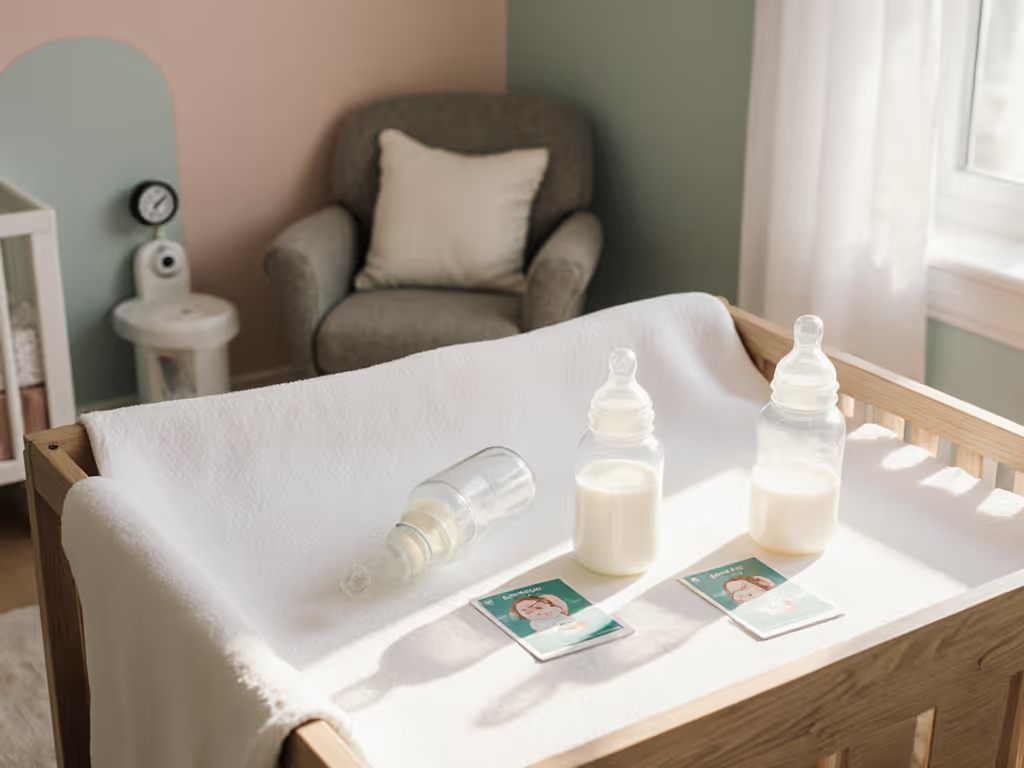
How to Introduce Bottles to Breastfed Baby Step-by-Step

Nearly 80 percent of parents worry about nipple confusion when starting bottles with breastfed babies. Making this transition smoother can ease feeding stress for both you and your child. From choosing the right bottle and nipple to mastering comfortable feeding positions, the right approach can help your baby adapt more easily and maintain a healthy, happy mealtime routine.
Quick Summary
| Key Point | Explanation |
|---|---|
| 1. Choose natural-feeling bottles and nipples | Select bottles and nipples that mimic breastfeeding textures and shapes to ease the transition for your baby. |
| 2. Prioritize slow-flow nipples for newborns | Use slow-flow nipples to match the sucking rhythm of breastfeeding, preventing frustration and promoting comfort. |
| 3. Maintain proper hygiene during preparation | Wash all feeding components thoroughly with hot water and mild soap to prevent contamination before each use. |
| 4. Introduce the bottle at the right time | Wait until breastfeeding is established (around four weeks) and choose calm moments for initial bottle introduction. |
| 5. Monitor your baby's feeding cues | Observe signs of hunger and fullness to ensure a responsive feeding experience that respects your baby’s needs and comfort. |
Step 1: Select the optimal bottle and nipple for breastfed babies
Choosing the right bottle and nipple is a critical first step when introducing feeding alternatives to your breastfed baby. Your goal is finding a bottle that feels natural and comfortable, mimicking the breastfeeding experience as closely as possible.
Start by understanding your material options. Medical experts recommend selecting nipples made from either latex or silicone, which offer different textures and durability. Silicone tends to be more long lasting, while latex provides a softer feel that some babies prefer. For bottles, you can choose between plastic and glass materials.
Flow rate matters significantly. Newborns require slow flow nipples that match the natural rhythm of breastfeeding. Rapid flow nipples can overwhelm your baby and create feeding frustration. Look for nipples specifically designed with a slow flow rate that matches your infant's sucking capacity.
Shape is another crucial consideration. Some babies prefer nipples that closely resemble a mother's breast shape. Anatomically shaped nipples can help reduce nipple confusion and make bottle transition smoother. Consider trying multiple nipple shapes to discover what your baby finds most comfortable.
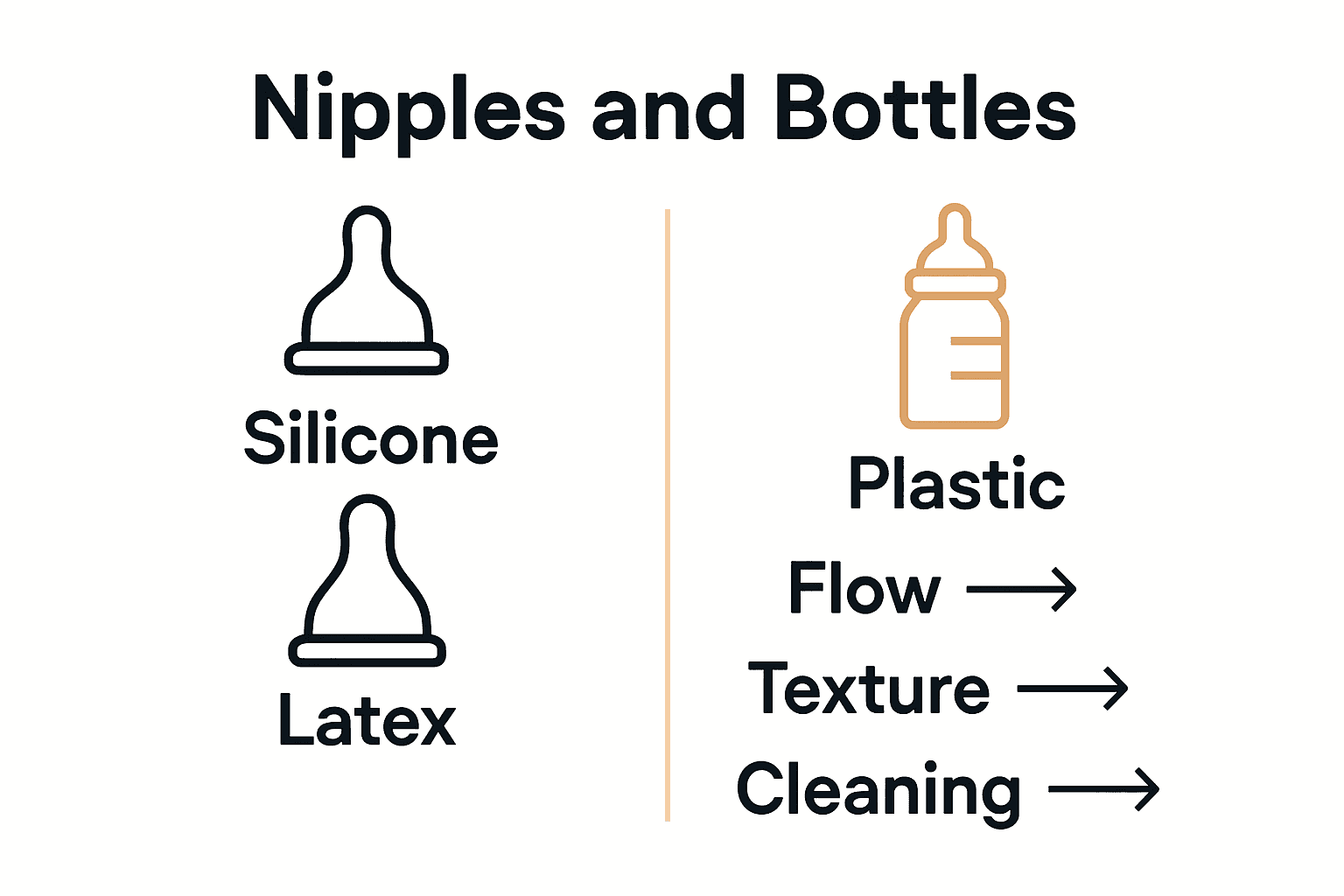
Here's a comparison of bottle and nipple options for breastfed babies:
| Feature | Silicone Nipple | Latex Nipple | Plastic Bottle | Glass Bottle |
|---|---|---|---|---|
| Texture | Firm | Soft | Light, flexible | Heavy, sturdy |
| Durability | Long-lasting | Wears faster | Can scratch | Highly durable |
| Sensation | Less natural feel | More breast-like | Modern standard | Eco-friendly |
| Cleaning Ease | Easy to sterilize | Can absorb odors | Easy to clean | Very easy to clean |
| Allergy Risk | Rare | Possible latex | Low | None |
| Flow Options | Slow, standard, fast | Slow, standard | Varies by nipple | Varies by nipple |
Pro Tip: Always test different bottle and nipple combinations before settling on one. Every baby has unique preferences, so patience during this selection process is key.
Once you've selected your initial bottle and nipple set, prepare for a potential adjustment period. Some babies adapt quickly, while others might need multiple attempts before accepting a new feeding method. Stay flexible and attentive to your baby's cues during this transition.
Step 2: Prepare bottles safely and mimic breastfeeding conditions
Now that you have selected the perfect bottle and nipple, its time to master the art of safe bottle preparation while creating an environment that feels as close to breastfeeding as possible. Your primary goals are maintaining hygiene and ensuring your baby feels comfortable and secure during feeding.
Start with a meticulous cleaning process. The Centers for Disease Control recommends thoroughly washing all bottle feeding supplies to prevent potential contamination. Use hot water and mild dish soap, scrubbing each component carefully.
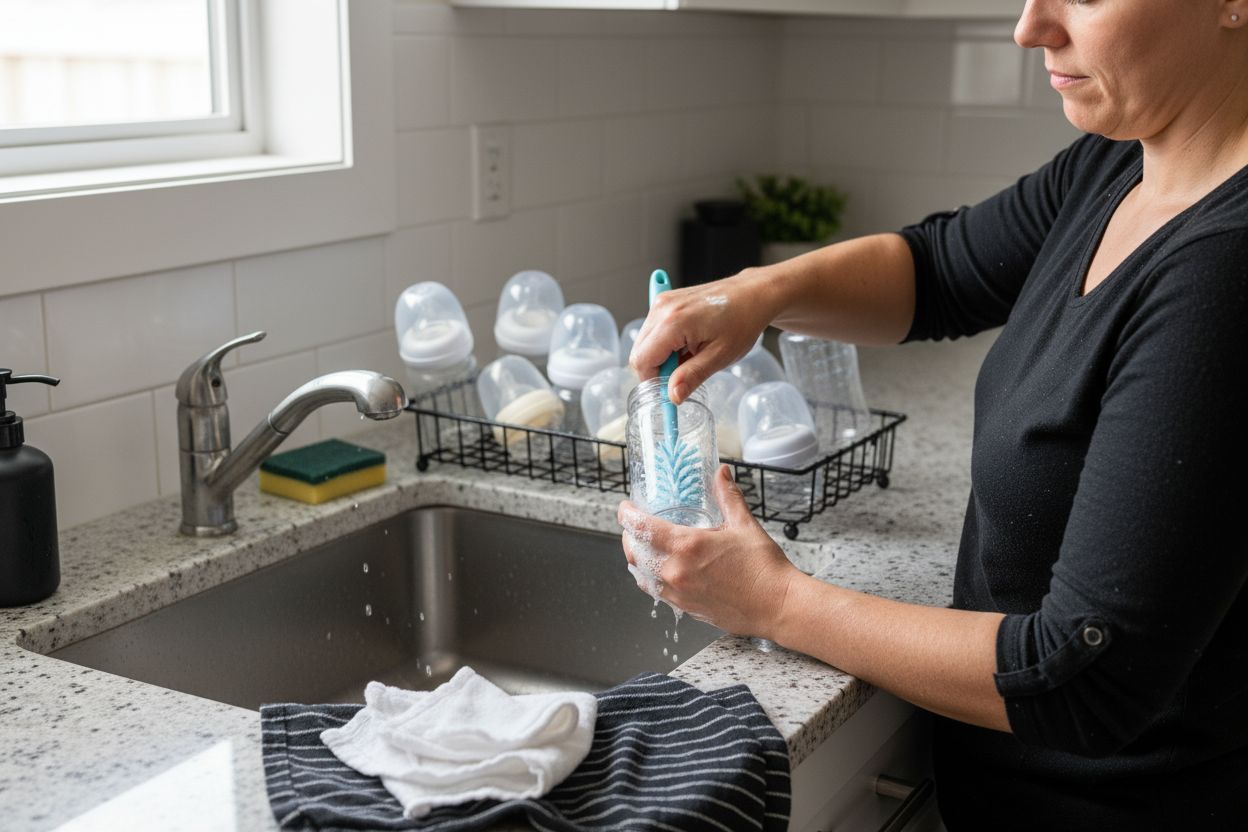 Consider using a specialized bottle brush that reaches into all the nooks and crannies of nipples and bottle necks.
Consider using a specialized bottle brush that reaches into all the nooks and crannies of nipples and bottle necks.
Positioning is key to mimicking the breastfeeding experience. Hold your baby semi upright at approximately a 45 degree angle to control milk flow. This angle allows your baby to suck and swallow comfortably while reducing the risk of ear infections and excessive air intake. Just like during breastfeeding, the bottle should be tilted so the nipple and neck remain continuously filled with milk.
To further replicate the breastfeeding dynamic, try switching sides during the feeding. This provides your baby with different visual perspectives and helps prevent developing a preference for one side. Gently shift your baby midway through the feeding, which can also help maintain engagement and prevent monotony.
Pro Tip: Skin to skin contact remains important even during bottle feeding. Consider removing some layers and holding your baby close to create a nurturing connection.
Remember that each baby adapts differently. Some will take to bottle feeding immediately, while others might need multiple attempts. Stay patient and attentive to your babys cues, adjusting your technique as needed to make the transition smooth and comfortable.
Step 3: Offer the first bottle at the right time and setting
Introducing a bottle to your breastfed baby requires careful timing and a thoughtful approach. The goal is to make this transition smooth and stress free for both you and your little one.
Experts recommend waiting until breastfeeding is well established before introducing a bottle typically around four weeks after birth. This timing helps prevent nipple confusion and ensures your baby has developed a strong breastfeeding rhythm. Choose a moment when your baby is calm and not overly hungry or completely full. A slightly hungry but not frantically so baby tends to be more receptive to trying something new.
Consider having someone other than the mother offer the first few bottles. Babies often associate their mother exclusively with breastfeeding and might be more willing to accept a bottle from another caregiver. This strategy can help reduce potential resistance and make the transition feel more natural.
Start with small amounts of expressed breast milk about one to two ounces to help your baby adjust. Hold your baby in a comfortable position similar to breastfeeding and allow them to set the pace. Some babies might take to the bottle immediately while others might need several attempts.
Pro Tip: Warm the bottle to body temperature and test the milk temperature on your inner wrist to ensure it feels just right.
Remember that patience is key. Some babies might need multiple tries before accepting a bottle. Stay relaxed and positive during these attempts as your baby can sense your emotional state. If one approach does not work try again in a few days with a different strategy or caregiver.
Step 4: Adjust techniques to minimize nipple confusion
Nipple confusion can be a challenging hurdle when introducing bottles to breastfed babies. Your mission is to make this transition as seamless and stress free as possible while keeping your babys feeding comfort at the forefront.
Start by allowing your baby to explore the bottle nipple naturally without forcing it into their mouth. Pediatric experts recommend a gentle approach where you let your baby touch and investigate the nipple at their own pace. Some babies might need multiple interactions before feeling comfortable with a new feeding method.
If your baby shows resistance or refuses the bottle, do not panic. Different nipple shapes and sizes can make a significant difference. Consider trying anatomically shaped nipples that more closely mimic a mothers breast. Some babies prefer wider base nipples that feel more familiar and provide a more natural latch.
Pay close attention to your babys cues during bottle introduction. Some infants might respond better to alternative feeding methods like a soft spoon or small cup. Responsive feeding means being flexible and willing to adjust your approach based on your babys unique preferences and comfort level.
Pro Tip: Warm the bottle nipple slightly to body temperature and consider using expressed breast milk to make the transition more appealing.
Remember that every baby is different. What works for one might not work for another. Stay patient and persistent. If one technique does not succeed immediately keep experimenting with gentle adjustments to find the perfect bottle feeding strategy for your little one.
Step 5: Monitor feeding response and ensure baby's comfort
Successfully introducing a bottle goes beyond the initial feeding. Your next crucial task is carefully observing your babys response and creating a comfortable feeding experience that supports their nutritional needs and emotional well being.
Start by paying close attention to your babys feeding cues. The Centers for Disease Control recommends watching for specific signals that indicate hunger and fullness. Watch for signs like turning toward the bottle when hungry and turning away when satisfied. These subtle body language signals help you understand your babys precise nutritional needs and prevent overfeeding.
Position matters during bottle feeding. Keep your baby in a semi upright position that allows them to control milk flow and swallow comfortably. Watch their facial expressions and body tension. A relaxed baby with smooth swallowing indicates they are comfortable and enjoying the feeding experience. Tension or frequent pausing might suggest discomfort with nipple flow or position.
Learn to recognize your babys fullness signals. Closing lips tightly closing eyes or pushing the bottle away are clear indications that they have had enough. Avoid pressuring your baby to finish the entire bottle if they show these signs. Responsive feeding means respecting their natural hunger and fullness rhythms.
Pro Tip: Track feeding amounts and times in a simple journal to help you understand your babys evolving nutritional patterns.
Remember that each feeding session is a learning opportunity. Some days will go smoothly while others might feel challenging. Stay patient flexible and attuned to your babys unique needs. With consistent observation and gentle adjustment you will create a positive bottle feeding experience that supports your babys growth and comfort.
Make Bottle Introduction Easier for Your Breastfed Baby Today
Introducing a bottle can feel overwhelming with concerns like nipple confusion and finding the right flow to keep your baby comfortable. The article highlights key challenges such as selecting the best nipple shape and flow rate while maintaining a calm feeding experience that closely mimics breastfeeding. If you are seeking to reduce feeding frustration and gently guide your baby through this important transition, you are not alone.
Discover how to solve these common bottle feeding issues with expert advice and tools designed especially for breastfed babies at Family Bottle Fit. Our site offers detailed guides on choosing the perfect bottles and nipples based on safety, flow compatibility, and your baby's unique feeding style. Don't wait until feeding struggles cause stress — start exploring proven strategies and trusted product recommendations to ensure smoother, more comfortable meals now. Visit Family Bottle Fit to find your customized bottle solution and transform your feeding routine today.
Frequently Asked Questions
How can I choose the right bottle and nipple for my breastfed baby?
To choose the right bottle and nipple, look for silicone or latex nipples with a slow flow rate to mimic breastfeeding. Test different shapes to find one that your baby prefers, as every infant has unique comfort levels.
When is the best time to introduce a bottle to my breastfed baby?
Introduce a bottle around four weeks after birth, once breastfeeding is well established. This allows your baby to develop a strong breastfeeding rhythm, making them more receptive to the bottle.
What should I do if my baby shows resistance to the bottle?
If your baby resists the bottle, allow them to explore the nipple at their own pace without forcing it. Be open to trying different nipple shapes and feeding methods, like offering expressed breast milk in a small cup.
How can I create a bottle-feeding environment that resembles breastfeeding?
To create a breastfeeding-like environment, hold your baby at a 45-degree angle during feeding and switch sides midway. This positioning helps your baby feel more secure and comfortable while mimicking their natural feeding habits.
How can I monitor my baby's feeding response and comfort with the bottle?
Pay close attention to your baby's hunger cues and fullness signals during feeding. If your baby turns away or pushes the bottle away, respect those cues and avoid forcing them to finish the bottle.
What are some tips to ensure safe bottle preparation for my baby?
Clean all bottle components thoroughly using hot water and mild dish soap to prevent contamination. Use a specialized bottle brush to ensure all parts are properly sanitized before each use.
Related Articles


Why Slow Flow Nipples Matter: Complete Guide
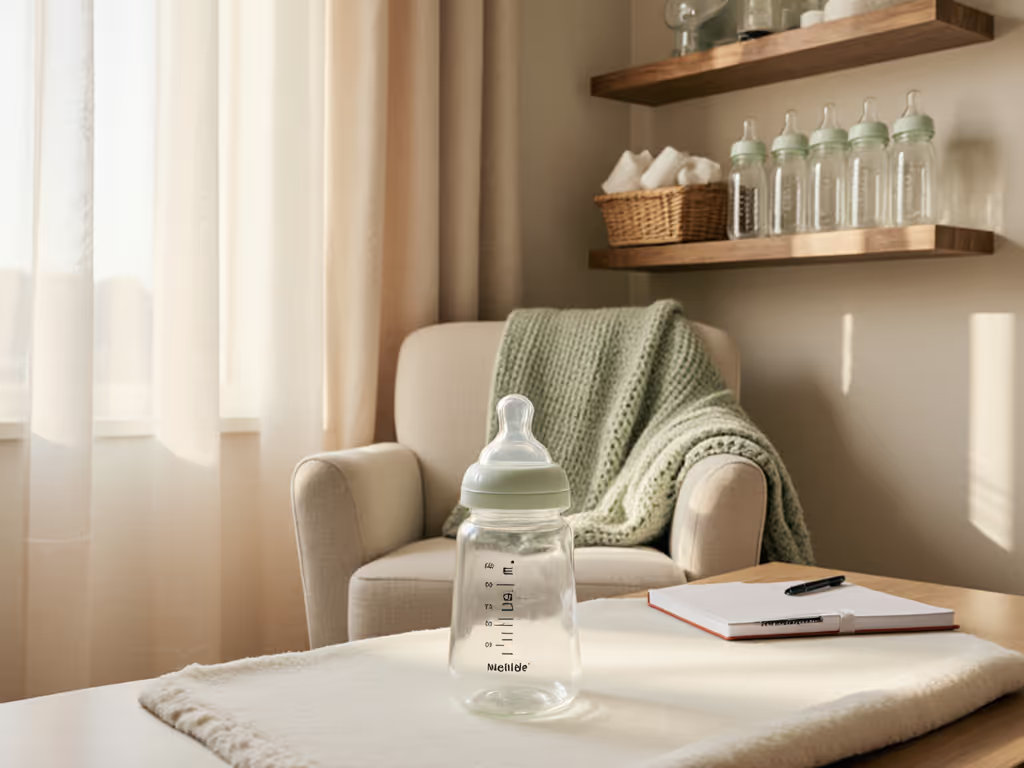
Step-by-Step Guide to Preventing Nipple Confusion Easily
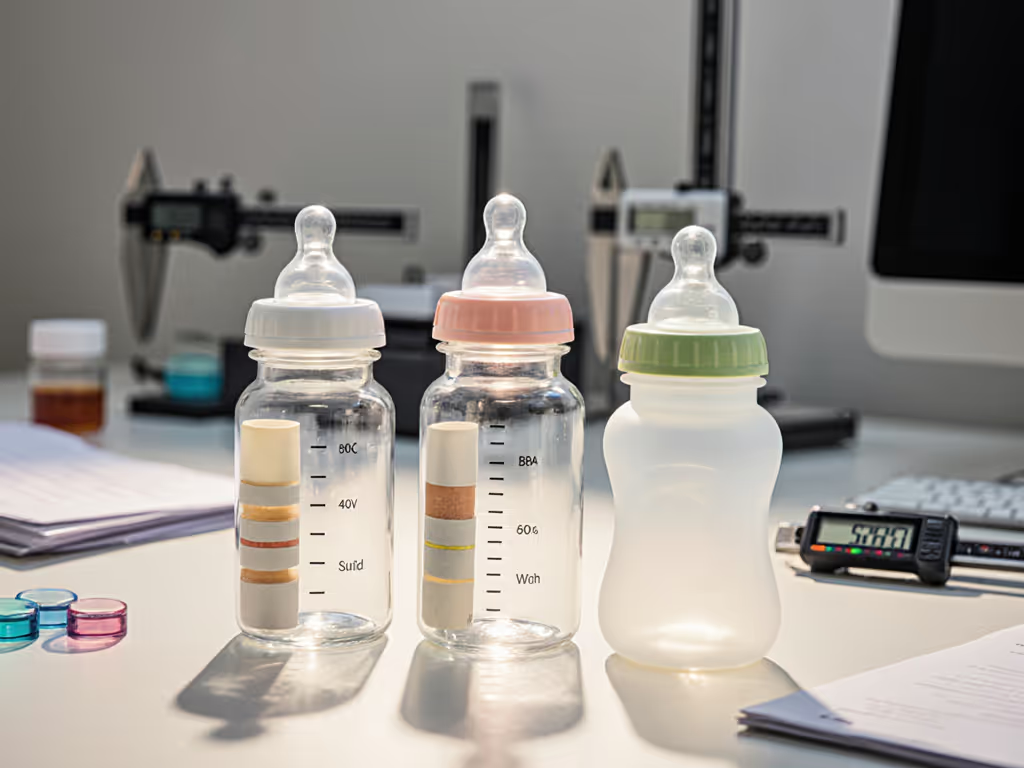
Complete Guide to the Role of Bottle Construction
